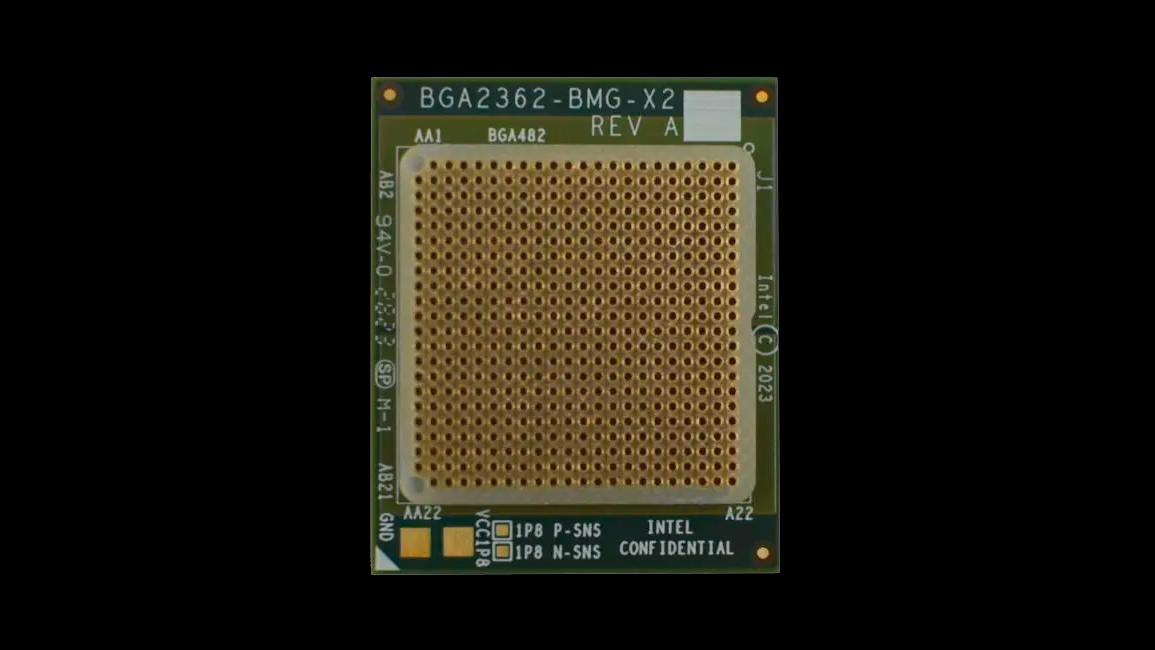
Intel's Arc Alchemist graphics cards have proven worthy to be on the list of best graphics cards. The chipmaker is readying its next-generation Battlemage graphics cards for 2024 and has released some test tools for its partners that hint at Battlemage's package sizes.
Intel has a Design-In Tools store that offers its partners design and validation tools for the chipmaker's existing and upcoming products. On this occasion, hardware sleuth Harukaze5719 discovered the BGA2727-BMG-X3-6CH and BGA2362-BMG-X2 interposers designed for testing Battlemage graphics cards. A previous Battlemage leak claims that Intel is reportedly preparing at least two silicon for the next-generation graphics cards: BMG-G10 (<225W) and BMG-G21 (<150W). In the meantime, it's uncertain if any of the silicon corresponds to the recently unearthed interposers. Remember that we're talking about package size, which differs from die size.
The X3 tool is the larger of the two interposers. X3 features a 2,727 BGA array design, whereas the X2 tool has a 2,362 BGA array design. As per the BGA2660-DG2-512EU-GRN interposer tool, DG2-512, which fathers the ACM-G10 die that powers the Arc A770 and Arc A750, sports a 2,660 BGA array. That means X3's package size is up to 2.5% larger than DG2-512. We don't know what codename Intel has planned for X3, but given the dimensions, it could be the successor to DG2-512.
On the other hand, the X2 shows a 2,362 BGA array design. We imagine it could be the direct replacement for the DG2-256 (ACM-G12). Unfortunately, while Intel offers an interposer for DG2-128 (ACMG-11), the chipmaker doesn't sell one for DG2-256, so we can't compare the two. However, the package size difference from DG2-128 (BGA1379) to X2 (BGA2362) is around 71.3%, so it's more likely that the X2 is closer to the DG2-256.
Intel Battlemage Package Size
Intel has confirmed that Battlemage will come in Xe2-HPG and Xe2-LPG flavors. Therefore, Battlemage won't just be present on discrete graphics cards. You'll also find Battlemage inside Intel's forthcoming processors, specifically Lunar Lake. According to a leaker, the integrated graphics solution inside Lunar Lake may wield as many as eight Xe cores, amounting to 64 Xe Battlemage execution units.
Like Alchemist, Intel won't produce Battlemage on its own. Instead, the chipmaker will again recourse to TSMC to help make Battlemage. A recent report states that Intel is going all-in with TSMC and has reportedly booked Celestial (the generation that will succeed Battlemage). For reference, Alchemist was on TSMC's 6nm process node. Intel hasn't confirmed which TSMC node it'll use for Battlemage, but many believe it's either the 5nm or 4nm node.
Assuming there are no setbacks, Battlemage will arrive in 2024. So far, Intel hasn't made much of an impact as the third player in the graphics card game despite Arc Alchemist being widely available and price cuts. Alchemist is Intel's first desktop graphics card in over 20 years, so you can't expect the company to get it right the first time, even with the Intel being as giant as it is. Let's hope that Intel has learned from Alchemist and leverage it for Battlemage.







